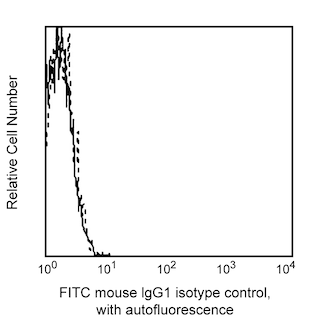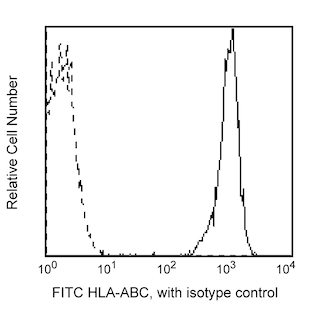Old Browser
Looks like you're visiting us from {countryName}.
Would you like to stay on the current country site or be switched to your country?


.png)

Flow cytometric analysis of HLA-ABC expression on human peripheral blood lymphocytes. Whole blood was stained with either FITC Mouse Anti-Human HLA-ABC (Cat. No.555552/560965/557348; solid line histogram) or FITC Mouse IgG1, κ Isotype Control (Cat. No. 555748; dashed line histogram). Erythrocytes were lysed with BD FACS™ Lysing Solution (Cat. No. 349202). Fluorescence histograms depicting HLA-ABC (or Ig isotype control) expression were derived from gated events with the forward and side light-scatter characteristics of viable lymphocytes. Flow cytometry was performed on a BD FACScan™ system.
.png)

BD Pharmingen™ FITC Mouse Anti-Human HLA-ABC
.png)
Regulatory Status Legend
Any use of products other than the permitted use without the express written authorization of Becton, Dickinson and Company is strictly prohibited.
Preparation And Storage
Product Notices
- This reagent has been pre-diluted for use at the recommended Volume per Test. We typically use 1 × 10^6 cells in a 100-µl experimental sample (a test).
- An isotype control should be used at the same concentration as the antibody of interest.
- Caution: Sodium azide yields highly toxic hydrazoic acid under acidic conditions. Dilute azide compounds in running water before discarding to avoid accumulation of potentially explosive deposits in plumbing.
- Source of all serum proteins is from USDA inspected abattoirs located in the United States.
- Species cross-reactivity detected in product development may not have been confirmed on every format and/or application.
- For fluorochrome spectra and suitable instrument settings, please refer to our Multicolor Flow Cytometry web page at www.bdbiosciences.com/colors.
- Please refer to www.bdbiosciences.com/us/s/resources for technical protocols.
Companion Products






The Human Leukocyte Antigen (HLA) complex is the human version of the MHC, helping the immune system distinguish the body's own proteins versus those from foreign invaders, such as viruses. Humans have three main MHC class I genes, known as HLA-A, HLA-B and HLA-C. Major histocompatibility complex (MHC) class I molecules, which are widely found on the surface of nucleated cells, function by binding peptides and displaying them on the cell surface to cytotoxic T-cells. Intracellular degradation of cytosolic proteins by the proteasome generates many of the peptides that load MHC class I molecules. MHC class I may also serve as an inhibitory ligand for natural killer (NK) cell receptors (KIR, Killer Immunoglobulin-like Receptors), which viruses may modulate expression levels for to evade immune detection. The G46-2.6 monoclonal antibody binds to a monomorphic epitope on the alpha chain of HLA-A, HLA-B and HLA-C.

Development References (1)
-
Barclay NA, Brown MH, Birkeland ML, et al, ed. The Leukocyte Antigen FactsBook. San Diego, CA: Academic Press; 1997.
Please refer to Support Documents for Quality Certificates
Global - Refer to manufacturer's instructions for use and related User Manuals and Technical data sheets before using this products as described
Comparisons, where applicable, are made against older BD Technology, manual methods or are general performance claims. Comparisons are not made against non-BD technologies, unless otherwise noted.
For Research Use Only. Not for use in diagnostic or therapeutic procedures.
Report a Site Issue
This form is intended to help us improve our website experience. For other support, please visit our Contact Us page.